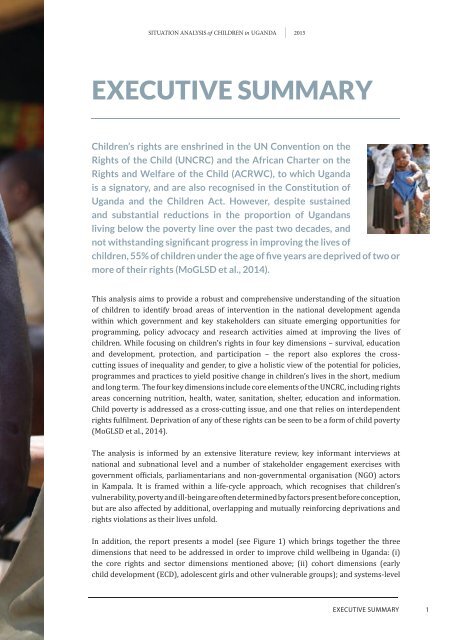Situation analySiS
1TNu802
1TNu802
Create successful ePaper yourself
Turn your PDF publications into a flip-book with our unique Google optimized e-Paper software.
<strong>Situation</strong> <strong>analySiS</strong> of Children in uganda 2015executive summAryChildren’s rights are enshrined in the UN Convention on theRights of the Child (UNCRC) and the African Charter on theRights and Welfare of the Child (ACRWC), to which Ugandais a signatory, and are also recognised in the Constitution ofUganda and the Children Act. However, despite sustainedand substantial reductions in the proportion of Ugandansliving below the poverty line over the past two decades, andnot withstanding significant progress in improving the lives ofchildren, 55% of children under the age of five years are deprived of two ormore of their rights (MoGLSD et al., 2014).This analysis aims to provide a robust and comprehensive understanding of the situationof children to identify broad areas of intervention in the national development agendawithin which government and key stakeholders can situate emerging opportunities forprogramming, policy advocacy and research activities aimed at improving the lives ofchildren. While focusing on children’s rights in four key dimensions – survival, educationand development, protection, and participation – the report also explores the crosscuttingissues of inequality and gender, to give a holistic view of the potential for policies,programmes and practices to yield positive change in children’s lives in the short, mediumand long term. The four key dimensions include core elements of the UNCRC, including rightsareas concerning nutrition, health, water, sanitation, shelter, education and information.Child poverty is addressed as a cross-cutting issue, and one that relies on interdependentrights fulfilment. Deprivation of any of these rights can be seen to be a form of child poverty(MoGLSD et al., 2014).The analysis is informed by an extensive literature review, key informant interviews atnational and subnational level and a number of stakeholder engagement exercises withgovernment officials, parliamentarians and non-governmental organisation (NGo) actorsin Kampala. It is framed within a life-cycle approach, which recognises that children’svulnerability, poverty and ill-being are often determined by factors present before conception,but are also affected by additional, overlapping and mutually reinforcing deprivations andrights violations as their lives unfold.In addition, the report presents a model (see Figure 1) which brings together the threedimensions that need to be addressed in order to improve child wellbeing in Uganda: (i)the core rights and sector dimensions mentioned above; (ii) cohort dimensions (earlychild development (ECD), adolescent girls and other vulnerable groups); and systems-levelExECUtIvE SUMMary1




